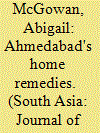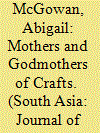|
|
|
Sort Order |
|
|
|
Items / Page
|
|
|
|
|
|
|
| Srl | Item |
| 1 |
ID:
123068


|
|
|
|
|
| Publication |
2013.
|
| Summary/Abstract |
Long known as innovative in modernist architecture, mid century Ahmedabad was also pioneering in another area of built form: housing. Starting in the 1920s when Indians seized control of urban politics, Ahmedabadis launched a number of bold new initiatives to improve housing in the city, involving a striking range of actors-labour activists, middle-class reformers, mill owners, and municipal leaders. Largely ignored under earlier British leadership, housing became a key way for Ahmedabadis to lay claim to a new, more inclusive vision of the city. Although housing continued to play a prominent role in politics after Independence, the 1950s actually marked a retreat from that earlier inclusive vision, ultimately enshrining the class and community segregation that marks Ahmedabad today.
|
|
|
|
|
|
|
|
|
|
|
|
|
|
|
|
| 2 |
ID:
144226


|
|
|
|
|
| Summary/Abstract |
In examining the remarkable expansion of India's textile production in the late colonial period, many scholars have identified consumption trends as shaping the relative success of mills as opposed to handlooms. That scholarship, however, has focused on only one component of consumption: clothing. This article explores another important area of cloth consumption in western India: non-clothing textiles. Across classes, urban dwellers used curtains and furnishing fabrics to try to improve comfort and create privacy—two qualities in short supply in cities like Bombay and Ahmedabad, where the pressures of rapidly growing populations came into conflict with new sanitary demands to open up houses to light and air. More broadly, non-clothing textiles helped to negotiate the novel conditions of urban life, where people moved regularly, homes were increasingly open to non-kin visitors, men and women shared space in new ways, and elite women were aesthetic arbiters of domestic space. While clothing choices in the late colonial period have often been studied in the context of nationalism, this article argues that nationalism was only one factor among many that shaped the use of household furnishing fabrics; equally, or more importantly, new ideas of ‘home’ led to and were expressed in expanded fabric use in urban western India.
|
|
|
|
|
|
|
|
|
|
|
|
|
|
|
|
| 3 |
ID:
178865


|
|
|
|
|
| Summary/Abstract |
Among the many nation-building projects launched soon after India’s Independence, crafts had a prominent role as a key way to support Indian culture, encourage diverse Indian production and build rural employment. These new efforts in crafts reveal the leadership of a group of powerful women, including most prominently Kamaladevi Chattopadhyay and Pupul Jayakar. Together, Chattopadhyay, Jayakar and others helped forge the idea of India as a crafts nation even as they made possible new roles for women within the fields of crafts. Powerful women operating in areas formerly dominated by men, they helped to shape the vision of crafts in the new state but faced important limits, revealing the narrow space for female leadership after Independence.
|
|
|
|
|
|
|
|
|
|
|
|
|
|
|
|
|
|
|
|
|